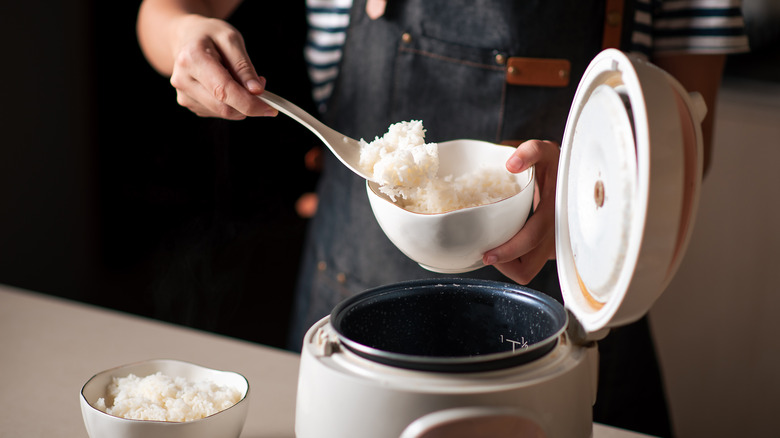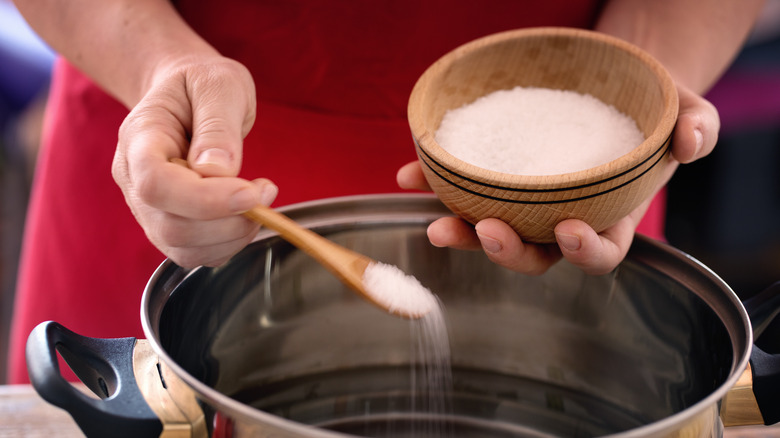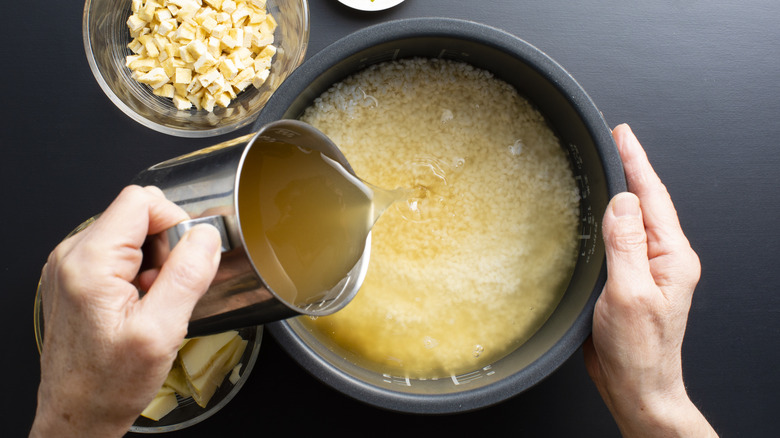The Seasoning Mistake You're Probably Making When Cooking Rice
Cooking rice seems so simple that you may not think to consult a recipe — which is why there's a good chance that you're making a mistake. If you have ever eaten a spoonful of mushy, overcooked rice or set off your smoke alarm by burning the grains at the bottom of your pot, you already know that timing is everything when it comes to rice. However, you might not realize that timing matters not just for the consistency of the rice, but for the flavor, too. To make perfectly prepared rice every time, award-winning chef JJ Johnson has some important advice: first cook, then season.
While many of us may be in the habit of adding salt to the water before starting to cook rice, Johnson advocates for delaying this crucial step until the end to ensure that the grains are prepared to fully soak in the seasoning. Because every kernel of raw rice has a tough exterior, it must be exposed to water and a certain amount of heat before it can begin to absorb liquids and take on other flavors. Johnson's method ensures that you are actually salting the rice, rather than just the water.
Why it matters when you season with salt
Salt is a flavor enhancer — it suppresses bitterness in foods while boosting sweet and umami qualities. Since rice has a mild taste, salt can help bring out its natural notes of earthiness and sweetness from the starches in it, making it less bland. To maximize this effect, you want the salt to be absorbed into the food, rather than just sprinkled on top. As Johnson points out, the trick to doing this when cooking rice depends on timing — which, in turn, is also a matter of temperature.
Rice becomes edible, soft, and absorbent when it undergoes a process known as starch gelatinization. Many grains also experience gelatinization when cooked, but for this particular one, the process occurs between about 138 and 162 degrees Fahrenheit. This is around the temperature range of simmering water (which is slightly below its boiling point at 212 degrees Fahrenheit). As the rice cooks, the kernels will start to swell. This is because the starch granules are taking in water. When the rice becomes fluffy and slightly sticky, it's ready to be seasoned.
Tips for the most flavorful rice
While you want to hold off on the salt, there are other ways to layer flavor into your rice while it's cooking. Johnson recommends trying different kinds of cooking liquids, rather than simply using tasteless, transparent water. If you're craving an intensely umami meal, you can cook your rice in pickle brine. Since the brine is usually made with water, salt, sugar, and some kind of vinegar, it offers a well-rounded variety of sweet, salty, and sour flavors. As a bonus, this hack helps you to avoid food waste and make the most of the ingredients you already have on hand. The brine on its own can be overpowering, so you'll need to water it down. To cook one cup of rice, use a blend of about ¾ water and ½ cup pickle brine.
If pickles aren't your thing, you can also swap in beer for the water when boiling rice. As with the brine, you'll want to dilute it so the cooking liquid is about half beer, half water. Opt for a pale ale or similarly mild beer, and avoid IPAs to achieve a pleasant balance of bitterness. For a lighter, more kid-friendly alternative, try making soft, fluffy coconut rice using coconut water. In this scenario, use 2 cups of coconut water for every cup of regular water to ensure your grains are infused with tropical flavor.



